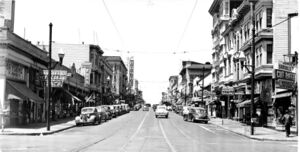A Citywide Blue-collar Economy Evaporates
Text by Joey Plaster. Copyright (©) by C. Joey Plaster, 2009. All rights reserved.
The emergence of the commercial haven was not an inevitable step forward for gay men, instead the result of citywide economic and cultural shifts.
Polk Street was originally created in the 1800s as an upscale commercial boulevard for the families who populated mansions on Van Ness Avenue, one of the city’s main thoroughfares. After the 1906 earthquake and fire razed the area, Van Ness became known as “Automobile Row.” Polk Street to a lesser extent supported the automotive industry. The immigrant German community built a German Cultural Center on Polk Street in 1912, where they held many of their community gatherings.
As in other cities, San Francisco’s population shrank during the 1950s, as large segments of the white population left the city for the suburbs. Between 1958 and 1962, while the number of blue-collar manufacturing jobs in San Francisco remained the same, finance, insurance and real estate grew by 20,000 new jobs.[1] Maritime employment in the city dropped as Port activity moved to Oakland, while San Francisco’s banking, finance, and tourism and convention industries dramatically expanded.
During the same time, San Francisco became a magnet for America’s counterculture, also witnessing a wave of immigration from Asia and Latin America and an influx of gay men, many of them World War II veterans.[2] By the late 1950s, the one room apartments in the Wentley Hotel and its 24-hour Foster’s Cafeteria on Polk Street were well-known hangouts for bohemians, gay men, workers, artists, male and female prostitutes, “wealthy retainers,” and beat poets, including Alan Ginsberg, according to Robert Potter.[3]
City and redevelopment advocates responded to economic shifts in the 1950s by proposing and implementing sweeping urban renewal projects and office building to make San Francisco more competitive with the suburbs by refashioning the downtown areas as the Bay Area’s financial hub.[4]
Historian Damon Scott argues that a cohesive, politicized gay community began to emerge in San Francisco queer bars in part due to threat posed by redevelopment to the waterfront and other central city gathering places for gay men at this time. In the process of keeping their hold in the area, sites known as “gathering places for sex deviates” became identified as “gay bars,” while the people who patronized them began to see themselves as a “community.” [5]
The most significant example of this shift, he argues, was the creation of the combined fundraising and business promotion activities of the League for Civil Education, an organization founded in 1961 by a group of bar hosts and patrons who began an effort to politicize gay bar patrons by building a gay voting bloc and promoting gay business through LCE News, a free bi-weekly newspaper supported by gay business revenue. Activists such as Guy Strait, as well as drag performers such as “Michelle” and Jose Sarria, leading figures in this early activism, would later become active on Polk Street.[6]
It was during the early 1960s, “as urban renewal destroyed the social spaces where gay men met and socialized during the 1950s,” that “these men made explicit claims to new spaces in the city.”[7]
- ↑ Chester Hartman, City for Sale: The Transformation of San Francisco, (University of California Press, 2002), 8.
- ↑ See Allan Bérubé, Coming Out Under Fire: The History of Gay Men and Women in World War II (New York: Plume, 1991).
- ↑ Interview with Robert Potter by Joey Plaster, 2008.
- ↑ Hartman, City for Sale: The Transformation of San Francisco, 33.
- ↑ Damon Scott, Ph.D. dissertation, “The City Aroused: Sexual Politics and the Transformation of San Francisco's Urban Landscape, 1943-1964,” Summer 2008, 240.
- ↑ Ibid., 237.
- ↑ Ibid., 203.
